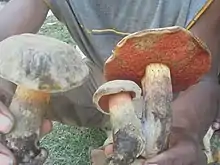| Boletus manicus | |
|---|---|
 | |
| Scientific classification | |
| Domain: | Eukaryota |
| Kingdom: | Fungi |
| Division: | Basidiomycota |
| Class: | Agaricomycetes |
| Order: | Boletales |
| Family: | Boletaceae |
| Genus: | Boletus |
| Species: | B. manicus |
| Binomial name | |
| Boletus manicus | |
| Boletus manicus | |
|---|---|
| Pores on hymenium | |
| Cap is convex | |
| Hymenium is adnate | |
| Stipe is bare | |
| Ecology is mycorrhizal | |
| Edibility is psychoactive | |
Boletus manicus is a species of fungus in the family Boletaceae of mushrooms. Found in the Wahgi valley Papua New Guinea, it was first described by French mycologist Roger Heim in 1963.[1] Heim singled out this mushroom largely because of its similar appearance to Rubroboletus satanas.[2] Reported to be psychoactive, the active principles are thought to be three indolic substances, but their concentration in the mushroom is too low to allow for chemical analysis and identification.[3]
In the Wahgi language it is called gegwantsyi ngimbl. The word ngimbl in the south Wahgi dialect means pain, which describes the intense bitterness of the mushroom.
See also
References
- ↑ Heim R. (1963). "Diagnoses latines des especes de champignons ou, nonda associes a la folie du komugl tai et du ndaadl". Revue de Mycologie (in French). 28 (3–4): 277–83.
- ↑ Heim, Roger (1972). "Mushroom madness in the kuma". Human Biology in Oceania. 1 (3): 170–178.
- ↑ Thomas B. (2003). "Boletus manicus Heim". Journal of Psychoactive Drugs. 35 (3): 393–4. doi:10.1080/02791072.2003.10400024. PMID 14621139. S2CID 31327216.
This article is issued from Wikipedia. The text is licensed under Creative Commons - Attribution - Sharealike. Additional terms may apply for the media files.